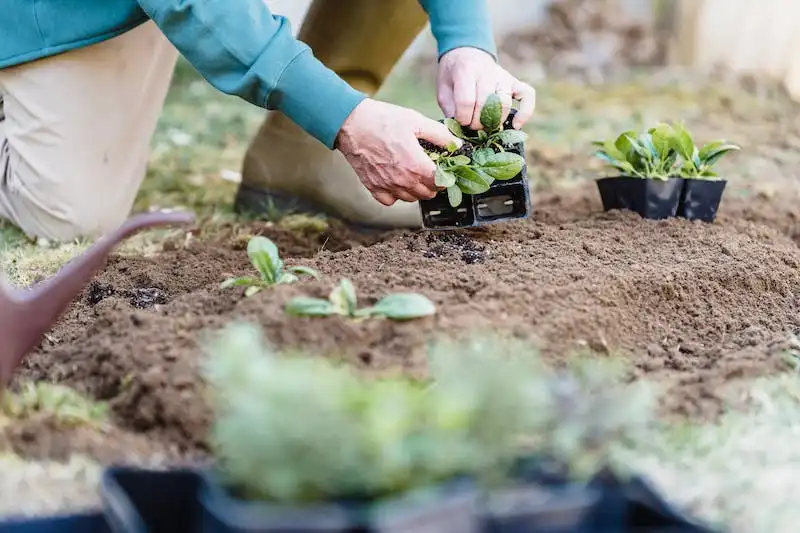Kohlrabi is a versatile and nutritious vegetable that is a member of the cabbage family. This unique vegetable has a mild and slightly sweet taste, and it can be eaten raw or cooked. If you are planning to grow kohlrabi in your garden, you may be wondering what plants to plant with kohlrabi to maximize your harvest and create a healthy growing environment. In this article, we will explore some of the best companion plants for kohlrabi and how they can benefit each other.
One of the benefits of planting kohlrabi with other plants is that it can help repel pests and protect your crops. For example, planting kohlrabi near tomatoes can help repel pests like aphids and whiteflies, which are common problems for tomato plants. Additionally, kohlrabi can attract beneficial insects like ladybugs, which can help control aphid populations and other harmful pests.
Another great companion plant for kohlrabi is cucumbers. These two plants have similar growth habits and can coexist well in the garden. The cucumbers can provide some shade for the kohlrabi, which can help prevent it from bolting and going to seed too quickly. In return, the kohlrabi can help deter cucumber beetles, which can harm the cucumber seedlings.
In some cases, kohlrabi can also benefit from planting it near other members of the cabbage family, such as broccoli or cauliflower. These plants have similar growing requirements and can help create a protective environment for each other. Their close proximity can also help conserve space in your garden and make it more efficient.
On the other hand, there are plants that should be kept away from kohlrabi. For example, kohlrabi should not be planted near asparagus, chives, or corn. Asparagus and chives can be invasive and may compete for resources with the kohlrabi. Corn can also create shading issues for kohlrabi and hinder its growth.
In conclusion, choosing the right companion plants for kohlrabi can greatly benefit the growth and health of the vegetable. By planting it near compatible plants, you can attract beneficial insects, repel pests, and create a protective environment. However, it is important to avoid planting it near incompatible plants that could harm its growth. With the right companions, your kohlrabi crop is sure to thrive and produce tasty and nutritious harvests!
Kohlrabi
Kohlrabi is a tender vegetable that belongs to the cabbage family. It has a round, bulbous shape with green or purple skin. The leaves are also edible and can be read in salads or cooked like spinach.
When it comes to planting kohlrabi, there are several companion plants that can help improve its growth and health. One important consideration is to clear the soil of any debris before planting, as kohlrabi is susceptible to pests and diseases that thrive on decaying plant matter.
Some good companion plants for kohlrabi include fennel, which helps to repel pests that can spread diseases to kohlrabi. Corn and celery are also good choices, as they provide shade and help to retain moisture in the soil.
If you’re choosing seeds for your kohlrabi, consider planting it with chives. Chives can help to deter pests that may cause damage to kohlrabi plants.
Another good companion plant for kohlrabi is eggplant. Kohlrabi needs ample phosphorus in the soil, and eggplants are known for their high phosphorus content. Additionally, eggplants can help to deter pests like the cabbage moth, which can cause damage to kohlrabi plants.
Kohlrabi is also a good companion plant for cauliflower. These two vegetables have similar growth habits and can be planted together to make the most of the available space. Plus, cauliflower and kohlrabi have similar nutrient needs, so they can benefit from being planted alongside each other.
Thyme is another herb that can be planted near kohlrabi. Its strong scents can help to repel pests and deter diseases from affecting kohlrabi plants. Thyme is also a great addition to the garden because of its culinary uses.
When it comes to planting kohlrabi, it’s best to avoid planting it near alliums, like onions and garlic. These plants can have negative effects on the growth of kohlrabi, so it’s best to keep them separate.
Another plant to avoid planting near kohlrabi is tomatoes. While tomatoes and kohlrabi can be harvested at the same time, they are susceptible to similar diseases. It’s best to rotate crops and plant kohlrabi in a different area of the garden than where tomatoes were previously planted.
If you want to add some fragrance to your garden, consider planting chamomile near kohlrabi. Chamomile has a pleasant aroma and can also help to repel pests that could harm kohlrabi plants.
Overall, kohlrabi has several companion plants that can help improve its growth and health. By choosing the right companions and considering the needs of kohlrabi, you can create a thriving garden that is both beautiful and productive.
About Kohlrabi
Kohlrabi is a commonly grown vegetable in gardens. It belongs to the cabbage family and is known for its unique shape and taste. Kohlrabi is often described as a mix between a cabbage and a turnip, with a mild and slightly sweet flavor.
The kohlrabi plant has a thick stem that grows just above the ground. The stem can be green, white, or purple, depending on the variety. The leaves of the kohlrabi plant are also edible and can be used in cooking.
Kohlrabi grows best in well-drained soil with a pH level between 6.0 and 7.5. It requires full sun to partial shade and can be planted either as a direct seed or as a starter plant.
When planting kohlrabi, it is important to leave enough space between each plant to allow for proper growth. The recommended spacing is about 6-8 inches apart in rows that are 12-18 inches apart. Kohlrabi plants should be planted alongside other vegetables that have similar planting and growing requirements.
Kohlrabi can be planted alongside vegetables such as tomatoes, kale, cabbage, asparagus, and pumpkins. These companion plants can help deter pests and improve the overall growth and health of the kohlrabi plants. Some herbs, like rosemary and dill, are also beneficial when planted near kohlrabi, as they can help repel harmful pests.
Kohlrabi plants require regular watering to keep the soil moist but not waterlogged. They should be watered at a rate of about 1-1.5 inches per week, depending on the weather conditions. Additionally, kohlrabi plants benefit from a balanced fertilizer application to provide them with necessary nutrients throughout the growing season. A fertilizer high in phosphorus is especially beneficial for kohlrabi plants.
Kohlrabi is typically ready to harvest within 55-60 days from planting. It is best to harvest the kohlrabi when the stem is about 2-3 inches in diameter, while the leaves are still small and tender. The leaves can be eaten just like kale or other leafy greens.
In conclusion, kohlrabi is a unique and delicious vegetable to grow in your garden. Its flavor and texture make it a versatile ingredient in various dishes. By planting it near compatible companion plants and providing proper care, you can enjoy a bountiful harvest of fresh kohlrabi that is both tasty and nutritious.
Read Next
When it comes to companion planting with kohlrabi, there are a variety of options that can help improve the health and yield of your plants. One great option is to plant chives alongside your kohlrabi. Chives not only add a burst of flavor to your meals, but they also attract beneficial insects that can help control pests. Additionally, chives are known to be excellent companions for brassicas like kohlrabi.
If you’re looking to improve your kohlrabi’s growth, consider planting chamomile nearby. Chamomile acts as a natural fertilizer, providing nutrients to your plants and improving their overall health. Plus, chamomile has beautiful bright flowers that add a pop of color to your garden.
Another companion plant for kohlrabi is celery. Celery has a deep root system that helps improve soil structure and allows for better water and nutrient uptake, which can benefit your kohlrabi plants. Additionally, celery can help protect your kohlrabi plants from pests, as its strong scent can mask the scent of the kohlrabi and make them less likely to be attacked.
If you’re growing kohlrabi alongside tomatoes in your garden, it’s important to know that these two plants compete for nutrients. To ensure that both plants thrive, make sure to provide them with a fertile soil that is high in phosphorus. Additionally, consider rotating your crops each year to prevent the buildup of diseases and pests in the soil.
For those who enjoy having a variety of flavors in their meals, planting nasturtiums near your kohlrabi is a great option. Nasturtiums not only add a beautiful touch to your garden with their bright flowers, but they also have a peppery flavor that can enhance your kohlrabi dishes. Plus, nasturtiums are known to repel pests, making them a beneficial companion for kohlrabi.
Lastly, if you’re having trouble with pests in your garden, planting mint near your kohlrabi can help. Mint is invasive, which means it spreads quickly and can keep pests away from your kohlrabi plants. Just be sure to plant mint in a container or use a barrier to keep it from taking over your entire garden.
By choosing the right companions for your kohlrabi plants, you can create a thriving and diverse garden that not only looks beautiful but also tastes delicious. So, if you’re looking to take your kohlrabi growing to the next level, be sure to read up on these companion plants and give them a try!




